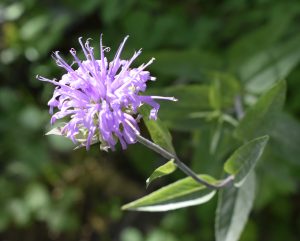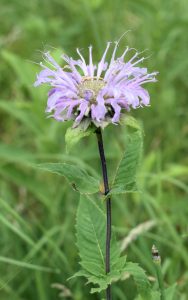Wild Bergamot
 Monarda fistulosa flowers start blooming at about the same time as the black-eyed Susans, June through August. Flowers appear about the time that Philadelphia fleabane is fading, while harebells are still in full swing. Besides the beauty of the exploding starburst of drama this flower gives us in sunny fields, roadsides and prairies, there are so many things to like and appreciate.
Monarda fistulosa flowers start blooming at about the same time as the black-eyed Susans, June through August. Flowers appear about the time that Philadelphia fleabane is fading, while harebells are still in full swing. Besides the beauty of the exploding starburst of drama this flower gives us in sunny fields, roadsides and prairies, there are so many things to like and appreciate.
 Wild bergamot is one of the most versatile and powerfully useful medicinal plants in N. America. Perhaps this is not surprising, as so many members of the Mint family offer soothing and healing qualities. The sweet, citrusy scent of this native plant lends itself well for use in flavorings as well as for its aromatic oil. My favorite thing about wild bergamot, at least at this point, is the attraction its luscious nectar affords to hummingbirds. Each solitary cluster on the end of branching stems holds individual tubular flowers, each tube filled with nectar that causes hummingbirds to linger at each flower head — and gives me a chance to enjoy them even longer! Bees and butterflies love this flower as well and visit often, which is why wild bergamot is otherwise known as bee balm.
Wild bergamot is one of the most versatile and powerfully useful medicinal plants in N. America. Perhaps this is not surprising, as so many members of the Mint family offer soothing and healing qualities. The sweet, citrusy scent of this native plant lends itself well for use in flavorings as well as for its aromatic oil. My favorite thing about wild bergamot, at least at this point, is the attraction its luscious nectar affords to hummingbirds. Each solitary cluster on the end of branching stems holds individual tubular flowers, each tube filled with nectar that causes hummingbirds to linger at each flower head — and gives me a chance to enjoy them even longer! Bees and butterflies love this flower as well and visit often, which is why wild bergamot is otherwise known as bee balm.
Sometimes wild bergamot is mistaken for the highly invasive, exotic spotted knapweed, which also has lavender, tubular flowers; the differences between them can easily be seen by comparing the tiny, narrow knapweed leaves to the wider leaves of bergamot. An additional difference appears when comparing knapweed’s long, bulbous bracts surrounding its flower base — clearly lacking in wild bergamot.
